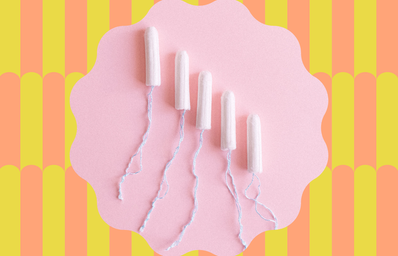A few weeks ago, I was living another regular Thursday, full of a hectic class schedule with a stale two-hour break I had to waste. After endless scrolling to try and capture my attention span, I came across a Tik Tok from creator Rachel Morgan of something that alarmed me and would grab the eyes and ears of any woman: “toxic” ingredients in a popular tampon brand that I, and many others, regularly purchase.
Morgan had explained that she saw a Tik Tok of a woman who claimed she experienced excess bleeding and irreversible uterine damage and is now being screened for cancer due to “poisonous” chemicals in her tampons, especially titanium dioxide.
Her Campus spoke to epigenetics expert Emily Brown, from the holistic menstrual care line, rhythm, on what’s really in our tampons, and which ingredients we should avoid when buying.
What is titanium dioxide?
After seeing the aforementioned Tik Tok, I went to look at the ingredients of the tampons I use to see how “organic” they really were. Everything in the ingredients list seemed normal (mostly cotton) until I got to the words titanium dioxide — which is used to keep the tampons white. After a bit of research, I discovered that titanium dioxide is in a lot of common products: Skittles, sunscreens, coffee creamers, makeup powders, and more.
Though the claims against titanium dioxide being toxic have been proven to be inaccurate, it is worth noting that this chemical began a six-month food additive ban in the European Union from February 2022 to August 2022, which then resulted in a permanent ban. This raises the question of why the United States allows these chemicals, especially in menstrual products, but other parts of the world protect their people from them.
So, what’s in our tampons?
According to Brown, feminine care products throughout history have been treated with chemicals that cause physical irritation to feminine health. One would think regulations would be set in place to reduce these health concerns but, oddly enough, period care products do not get looked at as closely as women would hope.
“Because [feminine care products] are classified as ‘medical devices’ they do not need to be screened at the highest standard,” Brown stated, “Nor are they required to disclose their ingredient list.”
Brown, an expert in sustainable menstrual health, said that tampons include several tainted ingredients, including fragrances, dioxins (bleaching), dyes, pesticides (non-organic), chemicals (chlorine), and synthetic or fake fabrics. And these ingredients may unknowingly affect women’s health.
“These are all toxins that build up and wreak havoc on our hormones, to our reproductive system, to our immune system (through allergies, cancer, and autoimmunity), and to our mood and mental health,” Brown said. “With so many sources of endocrine disruptors in our day-to-day lives now, it’s important that we become aware and protect ourselves from any avoidable sources.”
Brown concluded that, fortunately, period products are customizable to one’s preferences and there are several safe and sustainable options on the market. Brown recommended some of her favorite period products, the rhythm Classic Cup and Classic Disk, for they are sustainable and do not contain any toxins or chemicals.
Even though menstrual disks and cups are becoming more popular, if you are someone who feels more comfortable with tampon products, here are ingredients or chemicals to look out for while shopping for your next menstrual cycle.
These Are the Tampon Ingredients to Watch Out For.
FDA-approved tampons have to be made of either cotton, rayon, or a combination of both. Rayon is a synthetic material made from wood pulp used within tampons because of its strong absorbency compared to 100% cotton tampons and aids tampons to stay leak-proof. Unfortunately, due to rayon’s high absorbancy frequency, it can cause the rare phenomenon of Toxic Shock Syndrome (TSS) which only happens to 3 in 6 people out of 100,000 per year.
Cotton is the best ingredient in tampons but only if it does not contain additives such as bleaches and dyes. The cotton in many tampons is “bleached” or purified the fibers in cotton or rayon to keep the product clean and resulting in the cotton being white. To avoid dyed or bleached tampons, look for a brand that has 100% organic, cotton tampons with a small ingredient list.
Lastly, it’s important to stay away from pure cotton tampons that contain fragrance because they could irritate your body. Companies and retailers may use fragrance to their advantage by using words such as “clean” and “freshness” to describe how they improve your hygiene. In actuality, scented tampons can disrupt your body’s natural PH balance, which can lead to bacterial vaginosis (BV) or yeast infection which may need antibiotics to help cure. Another side effect can be irritation and itching due to the artificial perfumes attacking sensitive tissues and possibly leading to allergic reactions.
Clean and organic tampon products should be easy and accessible to find but unfortunately, it’s difficult to find tampons or other menstrual products that avoid the mentioned toxic ingredients when big companies like to brainwash women into maintaining “cleanliness” or pushing a more hygienic agenda. If you are someone concerned about finding organic tampons, your best bet is to buy them online, such as on Amazon, for they have more selections than any retail store. The best-reviewed organic tampons include Lola, Cora, Rael, The Honey Pot, and Seventh Generation.
Prioritizing women’s health should be ranked before convenience and cost for period-product brands, and if they can’t make non-toxic products, women will continue to work towards investing in safer alternatives.


